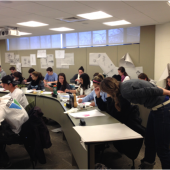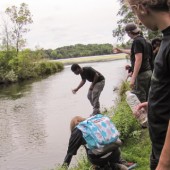
Held near Siena, Italy, our 3-week summer abroad program, The Mindful Palette of Stonehill College, combines art, gastronomy, and agricultural studies that strive for cultural mindfulness through holistic and experiential learning processes. A strong belief in sustainability, both philosophically and praxis, underlie these unique experiences. We share the complexities of attaining a sense of mindfulness with modern expectations and preconceptions. We address strategies to convince and support students to not only taste-test but to learn and embrace another culture and the environment through interdisciplinary activities and media formats. Through immersive and hands-on learning, we explore the intersections of food culture and the arts, so that students gain a comprehensive understanding of the impact of the handmade and the value of personal labor. A nose-to-tail mindset defines how and what materials we use. Until the modern era, art-making, food preparation, and scientific experiments were born out of the kitchen, both as laboratory and studio. The hearth was also the heart of the home—and therefore defined the family and cultural identity. Artistic practices that begin with the origins of our resources and have connections to the kitchen fortify our lessons and touch upon many of the aspects we find most important in the act of mindful learning—awareness of the self and the other, and our material’s origins and potential uses. They result in seeing how the daily and divine are one and the same.
Continue Reading
Here we describe how science learning can be enhanced through filmmaking. Combining the creative process of film production and its engaging storytelling and artistic components with science learning allows students to take ownership over their learning process and makes science accessible to learners who might not be reached through traditional science classrooms. We describe a model in which students develop a short film that investigates how climate and environmental change impacts their lives and their communities. Students are guided by college student mentors or teachers through a five-step program that includes: (1) selection and research of their topic, (2) development of a storyboard and script, (3) filming, (4) editing, and (5) a capstone screening event showcasing the final film. Through this process, students deepen their understanding of climate science and its complexity, while increasing their appreciation of the impacts of climate on society. Students also gain exposure to science and technology careers, while gaining confidence in their ability to complete a project.
Continue Reading
Engaging students not majoring in science, sustainability or environmental studies in learning environmental literacy and shifting their attitudes and behavior toward nature often requires a multi-perspective approach and presents unique challenges. We sought to: (1) pair artistic perspectives with botanical concepts to educate and interest our students in learning environmental literacy, (2) engage our students in careful observation and visualization of nature, and (3) increase the environmental sensitivity of our students by connecting botany with nature based art. To do this we designed a pre-class assignment, an in-class botanical art workshop, and a written reflection assignment that asked students to view, conceptualize, and create works of botanical art as a multi-perspectival process of engaging with relevant scientific processes and environmental concerns connected to botany. Here we provide a justification for the value of bridging science with art, detail our approach, describe student survey responses and thoughtful written reflections, and illustrate lessons learned and future plans.
Continue Reading
This case study describes an art-led environmental education project at an environmental charter high school in Minnesota. The project is a pilot of the model called Earth Systems Journey, and the theoretical approach of this model is summarized. Its goal is to provide experiential integration: a sense of self and place that are integrated with each other. The case study project, called “River Journey: Exploring the Value of the Mississippi River,” took place in the 2014-2015 school year with students in grades 9-12. River Journey takes students on a journey of their place in the local water cycle to discover how the water that flows through their school’s kitchen sink is interconnected, both upstream and downstream, to the Mississippi River through water and wastewater treatment and distribution infrastructure. Students create a GIS story map as a way to reflect on and integrate their learning and as a public educational resource. The idea of river exploration expands throughout the curriculum in the second half of the year, and another set of GIS story maps explore the river from the perspective of personal stories, population-water resource tensions, water as a strategic element in the Civil War, and ecological issues that occur along the length of the Mississippi River. Art and story inform the design of the journey and its dramatic props, including GIS, used throughout the experience.
Continue Reading
A personal reflection, from the professors’ perspective, of an arts integrated learning tool created to teach systems concepts in college level environmental studies and sustainability courses.
Continue Reading